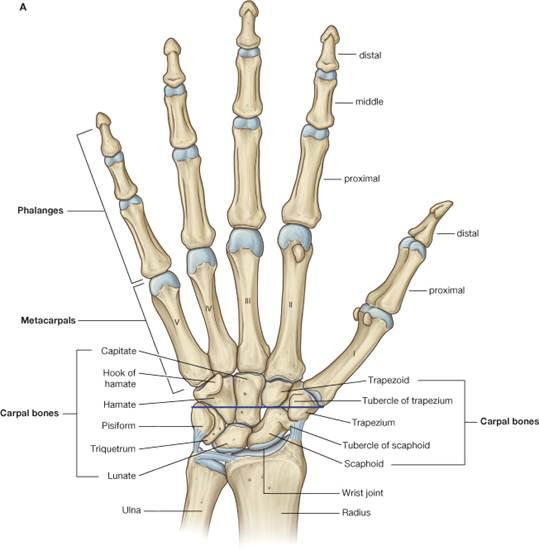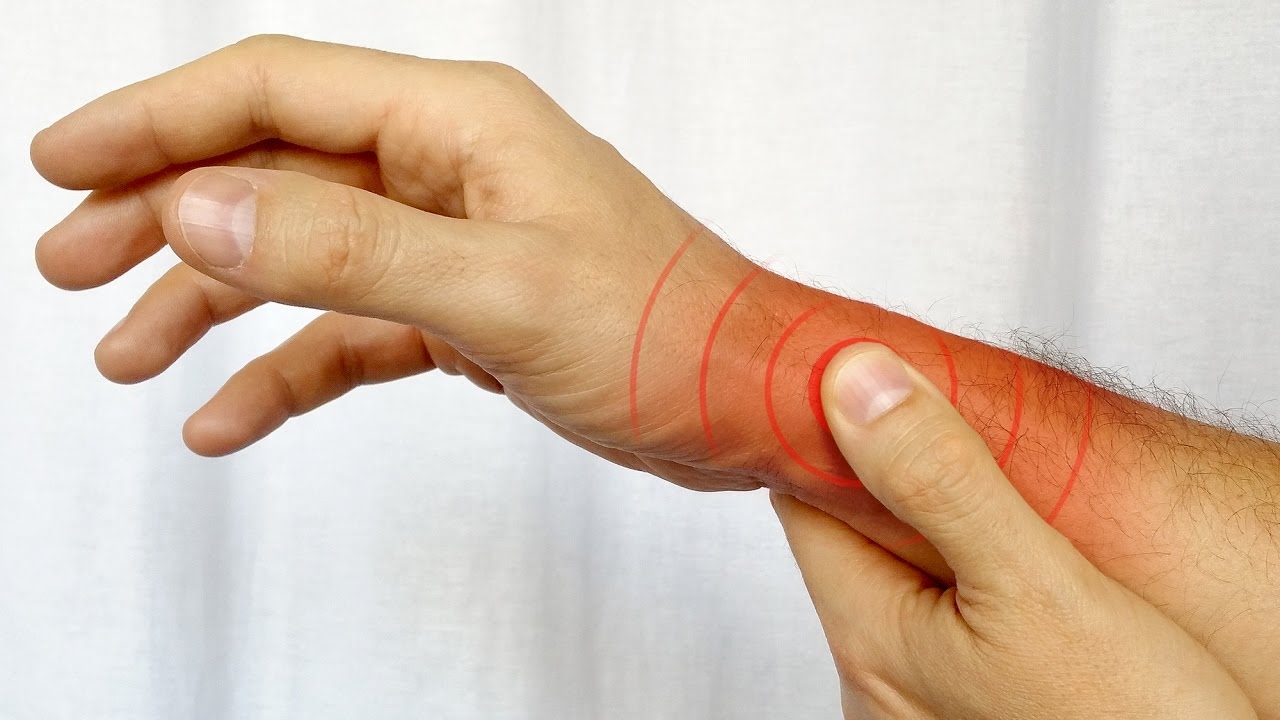The human body is comprised of hundreds of different joints, but only a select few can rival the wrist for its amazing complexity.
It is an incredible joint. The intricacy of the eight carpal bones that connect the radius and ulna to the hand is a delight, and these bones work in tandem to produce a fully functioning wrist movement. Alongside the bones are a series of constricted ligaments that keep the bones together, doing their best to ensure that the wrist can keep up with the usage that comes with the most common of daily tasks. Regrettably, wrist arthritis can occur as the joint wears down over time. From pushing a pin into a notice board to driving a fork-lift, spinning records to making a cup of tea, all actions have consequences. Essentially, this wearing down is what we know to be osteoarthritis. It brings limited motion to the wrist joint, along with inflammation and pain.

Anatomy of the wrist.
What is osteoarthritis?
Osteoarthritis, or OA, is defined simply as a type of joint disease that occurs when the joint cartilage, and underlying bone, begin to breakdown or wear away. This brings about common symptoms such as stiffness and aching pain. To begin with, one may find that the symptoms present themselves post-activity or exercise – they can, however, become a daily grievance for arthritis sufferers. Taken from the recent article ‘Wrist Arthritis – 11 Telling Signs’, here are some of the key indicators of early OA:
- The earliest of the symptoms is stiffness in the wrist, and this most commonly presents itself in the morning. The pain will usually ease as the day goes on.
- If the joint cartilage has deteriorated beyond immediate repair, one may begin experience a painless crunching sound upon using the wrist joint. This is the sound of the carpal bones grinding.
- There are two key factors that differentiate OA from rheumatoid arthritis. Firstly, the inflammation and swelling around the wrist joint is not hot-to-touch. Secondly, OA does not present itself in a symmetrical pattern – this means it can develop on one side of the body.
- The most common, early symptoms of osteoarthritis in the wrist are inflammation and stiffness. Not to be confused with rheumatoid arthritis, which produces inflammation that is hot-to-touch.
What causes osteoarthritis?
Many people don’t have a thorough understanding of cartilage and the job it does. It is a tough, yet supple tissue component in one’s joints. It acts to facilitate smooth movement by providing padding and absorbing shock across the surface of a joint. The cartilage in the human body is smoother than any resource or product that we can create ourselves, think the ultimate non-stick frying pan. Naturally, we use our joints daily to undertake a wide range of different tasks. With that comes a gradual deterioration of the cartilage. Over time it loses its smoothness, which leads to inflammation of the joint.
What is rheumatoid arthritis?
Rheumatoid arthritis, or RA, is an autoimmune disease. One’s immune system is designed to combat infections and foreign cells by sending antibodies (white blood cells) to kill them off. This keeps a person healthy on a day-to-day basis. With RA, one’s immune system mistakes the lining of the joints for foreign cells. Believing that these cells pose a risk to one’s wellbeing, the autoimmune system will proceed to target the joint lining. As above, the resulting symptoms were highlighted in a recent article. Here is a recap:
- As with OA, the most commonly experienced symptoms are stiffness and inflammation. The key difference here, however, is that with RA the inflammation as the result of an autoimmune disease. Therefore, he inflammation will likely be hot-to-touch.
- Unlike OA, RA presents itself symmetrically meaning that if one side of the body is experiencing symptoms then the likelihood is the other will begin to, too.
- On occasion, the symptoms may be external from a problem with the wrist joints themselves. This is due to the fact RA is ‘systemic.’ Systemic diseases highlight problems elsewhere across one’s bodily system. Other bodily symptoms include swollen glands, a loss of colour in the skin, decrease in appetite and tiredness.
There is no definitive cause behind rheumatoid arthritis, so we can’t say for certain at this moment what causes the body’s autoimmune system to go into overdrive. There is, however, some evidence to suggest that certain lifestyle traits may have an impact on one’s risk of developing RA.
- Smoking.Although the underlying logistics behind the connection has yet to been scientifically pinpointed, it has long since been agreed that there is a correlation between increased smoking and risk of RA. The smoking of cigarettes is widely accepted as one of, if not the greatest environment risk factors in modern science. It can be attributed to the development of most major diseases, an example of which is lung cancer.
- Eat an excess of red meat. The pro-inflammatory hormone is made up of the same acids as omega-6, which is the fatty acid in red meat. So, the more of that in one’s system, the more likely you are to suffer from inflammatory disorders. A diet swap to include more omega-3 (found in fish) can counteract this.
Managing the pain of wrist arthritis
Pain, by definition, is the body sending signals to the brain when something is wrong. In this case, the irritation in the wrist will stimulates the local nerves which transmit the sensations to the brain. Arthritis sufferers will say that they experience pain in the wrist at least once a day, and the pain presents itself through the common symptoms outlined above. We can categorise the pain into two different types:
- Acute. Acute pain occurs only in the short-term. It is the pain you experience when you have initially been hurt, starting suddenly and subsiding after an undetermined period. It is, for example, the short twinge one feels every now and again. It alerts one’s brain when something isn’t right.
- Chronic. Chronic pain occurs persistently. Those who are suffering with developed arthritis will likely describe their pain as chronic.
Arthritis Care outline four key points to help one manage their pain:
- By finding new, more effective ways to use the wrist joint, one can reduce the strain they are putting on the joint and subsequently make everyday tasks easier to manage. They highlight a respect for pain as a key component here, suggesting that one shouldn’t put themselves through pain just to reach an end goal. Instead, look to work oneself into a routine that requires less effort. Further, they propose delegating tasks to the body’s stronger muscles or joints wherever possible. An example of this would be using a backpack, as opposed to a briefcase. If you’re looking for wrist supports for arthritis, get in touch with your doctor and they will provide you with all the information you need.
- Rest and relax. The second point centres around rebuilding a lifestyle that doesn’t adhere to the pain of arthritis. A more positive outlook can be provided through a healthy, balanced diet and general exercise. Incorporating relaxation techniques such as meditation or deep breathing can prove very beneficial when dealing with stress, and one may find local classes with free taster sessions to give this a try.
- One may ask their GP about the possibility of complementary therapies to help them ease their pain. A GP may be able to make a referral to an acupuncturist, herbalist or masseuse depending on the type of arthritis. Don’t be afraid to give things like this a try, as they often go hand in hand with point two, and work to provide a more positive, optimistic outlook on life.
- A more obvious form of pain relief can come through medication. Drugs such as painkillers, non-steroidal anti-inflammatories and anti-depressants are typically prescribed to arthritis sufferers who are experiencing chronic pain. They can help improve quality of life throughout the day, but also, help one gain a better night’s sleep if they are suffering from pain overnight.
- Performing wrist exercises and stretches can help to increase one’s pain threshold. Wrist arthritis support is vital to managing it – This video contains some useful starter stretches to help wrist arthritis sufferers:
Different types of treatment for wrist arthritis
Highlighted above are examples of pain management techniques that people can implement into their lifestyles. Yet, what is available for wrist arthritis sufferers that require further treatment to alleviate their symptoms?
It is important to remember that, unfortunately, there is no known cure to the symptoms of wrist arthritis. However, there are further wrist arthritis treatment methods to provide further respite:
- Steroid injections. The steroids reduce the activity of the immune system, which helps treat autoimmune conditions such as rheumatoid arthritis. Most steroid injections can be administered by your GP. They do not cure the underlying arthritis problem, rather, they work to provide an ease in pain or swelling. The respite lasts from anywhere between one week to two months, but there are also long-acting steroids that take longer to start working, but have longer positive effects.
- Surgery. Surgery is usually considered for wrist arthritis treatment cases that present disabling pain despite the application of nonoperative treatment. Surgery will also be considered if there is deformity in the hand. If there is arthritis between only a select few of the 8 carpal bones, it is possible for a hand and wrist surgeon to remove the worn-down section. This would limit the available wrist motion whilst providing major pain relief.
- Partial fusions. A fusion is when two or more bones are brought together to form one, cohesive bone structure. The worn-down section of the wrist would be surgically removed, and the remainder is held together with pins, screws or plates. This is a high-intensity treatment that will only be used in severe cases.


